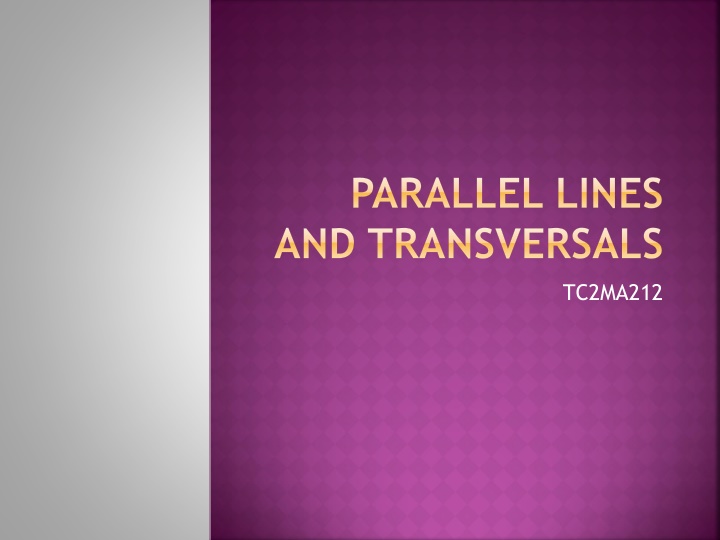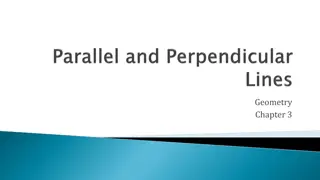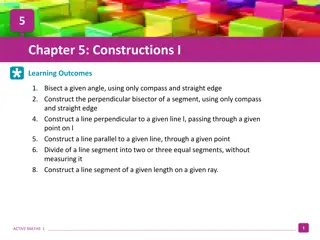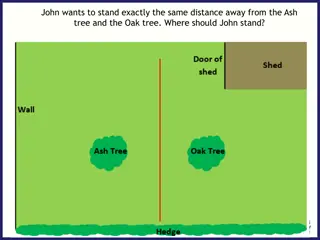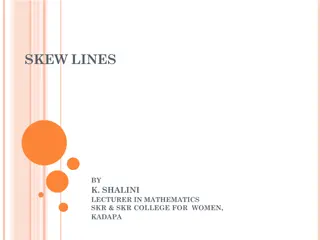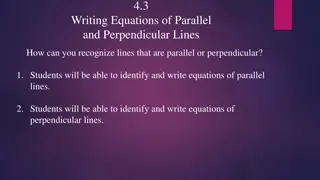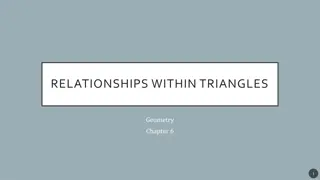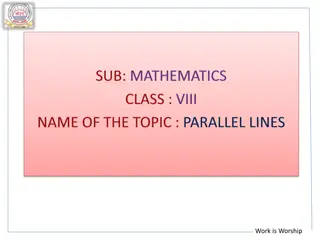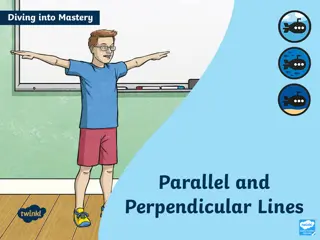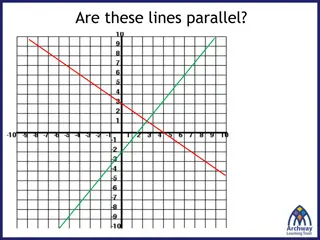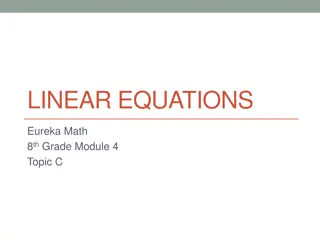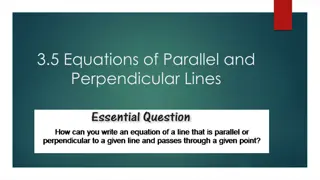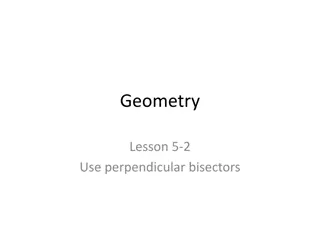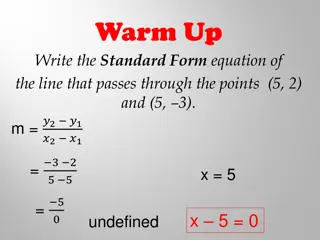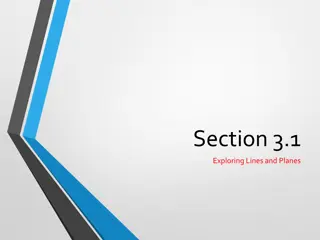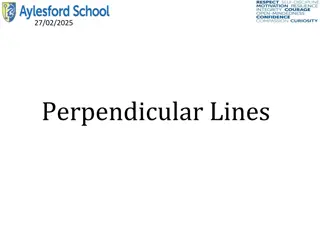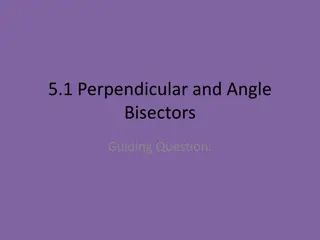Parallel and Perpendicular Lines in Geometry
Explore the concepts of parallel and perpendicular lines along with transversals, vertical angles, supplementary angles, linear pairs, corresponding angles, and their properties in geometry. Learn about the relationships between different types of angles formed by parallel lines and transversals, and enhance your understanding of basic geometry principles.
Download Presentation

Please find below an Image/Link to download the presentation.
The content on the website is provided AS IS for your information and personal use only. It may not be sold, licensed, or shared on other websites without obtaining consent from the author.If you encounter any issues during the download, it is possible that the publisher has removed the file from their server.
You are allowed to download the files provided on this website for personal or commercial use, subject to the condition that they are used lawfully. All files are the property of their respective owners.
The content on the website is provided AS IS for your information and personal use only. It may not be sold, licensed, or shared on other websites without obtaining consent from the author.
E N D
Presentation Transcript
PARALLEL LINES AND TRANSVERSALS TC2MA212
PARALLEL LINES Def: line that do not intersect. B B Illustration: A A D D l C C m m l || m Notation: AB AB || CD CD
PERPENDICULAR LINES Def: Lines that intersect to form a right angle. m Illustration: n Notation: m n Key Fact: 4 right angles are formed.
TRANSVERSAL Def: a line that intersects two lines at different points t Illustration:
VERTICAL ANGLES Two angles that are opposite angles. t 1 4 2 3 5 8 6 7 1 2 4 3 6 5 7 8
THEOREM: Vertical angles are congruent. t 1 2 4 3 6 5 7 8
VERTICAL ANGLES Find the measures of the missing angles t 125 ? 125 ? 55 55
SUPPLEMENTARY ANGLES/ LINEAR PAIR Two angles that form a line (sum=180 ) t 1+ 2=180 2+ 4=180 4+ 3=180 3+ 1=180 5+ 6=180 6+ 8=180 8+ 7=180 7+ 5=180 1 2 4 3 6 5 7 8
SUPPLEMENTARY ANGLES/ LINEAR PAIR Find the measures of the missing angles t ? 108 72 ? 108 180 - 72
CORRESPONDING ANGLES Two angles that occupy corresponding positions. t 1 5 2 6 3 7 4 8 Top Left Top Right 1 2 3 4 Bottom Left Bottom Right Top Left Top Right 5 6 7 8 Bottom Left Bottom Right
CORRESPONDING ANGLES CORRESPONDING ANGLES POSTULATE POSTULATE If two parallel lines are cut by a transversal, then the pairs of corresponding angles are congruent. 1 2 1 2
CORRESPONDING ANGLES Find the measures of the missing angles t 145 35 ? 145
ALTERNATE INTERIOR ANGLES Two angles that lie between parallel lines on opposite sides of the transversal t 1 2 3 6 4 5 3 4 5 6 7 8
THEOREM 1: ALTERNATE THEOREM 1: ALTERNATE INTERIOR ANGLES INTERIOR ANGLES If two parallel lines are cut by a transversal, then the pairs of alternate interior angles are congruent. 3 4 3 4
PROVING PROVING THE ALTERNATE THE ALTERNATE INTERIOR ANGLES THEOREM INTERIOR ANGLES THEOREM Given: p q Prove: 1 2 1 2 3
PROOF PROOF Statements: 1. p q 2. 1 3 3. 3 2 4. 1 2 Reasons: 1. Given 2. Corresponding Angles Postulate 3. Vertical Angles Theorem 4. Transitive Property of Congruence
ALTERNATE INTERIOR ANGLES Find the measures of the missing angles t 82 98 82 ?
ALTERNATE EXTERIOR ANGLES Two angles that lie outside parallel lines on opposite sides of the transversal t 1 2 2 7 1 8 3 4 5 6 7 8
ALTERNATE EXTERIOR ANGLES Find the measures of the missing angles t 120 ? 60 120
THEOREM 3: ALTERNATE THEOREM 3: ALTERNATE EXTERIOR ANGLES EXTERIOR ANGLES If two parallel lines are cut by a transversal, then the pairs of alternate exterior angles are congruent. 7 8 7 8
CONSECUTIVE INTERIOR ANGLES Two angles that lie between parallel lines on the same sides of the transversal t 1 2 3 + 5 = 180 4 + 6 = 180 3 4 5 6 7 8
CONSECUTIVE INTERIOR ANGLES Find the measures of the missing angles t 180 - 135 135 45 ?
THEOREM2: CONSECUTIVE THEOREM2: CONSECUTIVE INTERIOR ANGLES INTERIOR ANGLES If two parallel lines are cut by a transversal, then the pairs of consecutive interior angles are supplementary. 5 6 5 + 6 = 180
USING USING PROPERTIES OF PROPERTIES OF PARALLEL LINES PARALLEL LINES Given that m 5 = 65 , find each measure. Tell which postulate or theorem you use. A. m 6 C. m 8 D. m 9 B. m 7 9 6 8 5 7
SOLUTIONS: SOLUTIONS: m 6 = m 5 = 65 Vertical Angles Theorem m 7 = 180 - m 5 =115 Linear Pair postulate m 8 = m 5 = 65 Corresponding Angles Postulate m 9 = m 7 = 115 Alternate Exterior Angles Theorem a. b. c. d.
